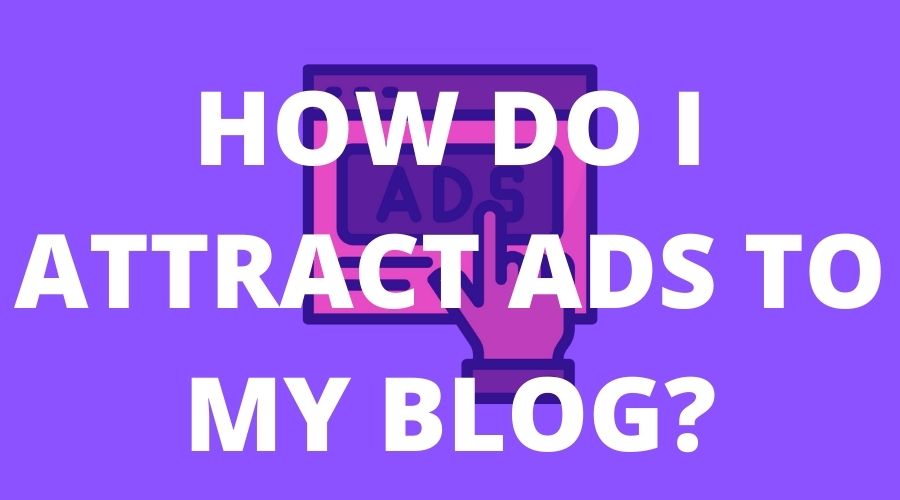Are you a blogger looking to monetize your platform and attract advertisers? If you’re wondering how to make your blog more appealing to potential sponsors, you’re in the right place. In this article, we’ll explore effective strategies that can help you attract advertisers and generate income from your blog. From optimizing your content to building a strong online presence, we’ll guide you through the steps you need to take to attract advertisers to your blog. Let’s dive in!

This image is property of www.shoutmeloud.com.
1. Create High-Quality Content
1.1 Write Engaging and Valuable Blog Posts
When it comes to attracting advertisers to your blog, creating high-quality content is key. Advertisers are looking for blogs that have a strong readership and engaged audience, and the best way to achieve this is by writing engaging and valuable blog posts.
Start by identifying topics that are relevant to your target audience and that align with your blog’s niche. Conduct thorough research, gather credible information, and present it in a way that is informative, entertaining, and easy to understand. Use storytelling techniques, incorporate visuals, and make sure your writing is concise yet captivating.
By consistently producing blog posts that provide value to your readers, you’ll not only attract more traffic to your blog but also build credibility and trust with potential advertisers. They’ll see that your blog is a valuable platform for reaching their target audience, and will be more likely to consider partnering with you.
1.2 Publish Regularly
Consistency is key when it comes to attracting advertisers to your blog. It’s important to establish a regular publishing schedule and stick to it. By consistently publishing new content, you’ll demonstrate to advertisers that your blog is actively managed and that you have a dedicated audience that engages with your posts regularly.
Develop a content calendar and plan ahead to ensure a steady stream of blog posts. This will also help you manage your time and stay organized. Remember to maintain the quality of your content while focusing on quantity. Aim for a balance between providing valuable information and keeping your readers engaged.
The more you publish, the more opportunities you have to attract new readers and potential advertisers. Make a commitment to publishing regularly and watch your blog’s audience grow.
1.3 Optimize Your Content for Search Engines
In addition to creating engaging content, it’s important to optimize your blog posts for search engines. This will help improve your blog’s visibility and attract organic traffic. Advertisers are often more interested in blogs with a high search engine ranking, as they want their advertisements to be seen by as many people as possible.
To optimize your content, start by conducting keyword research. Identify relevant keywords and include them naturally throughout your blog posts. This will help search engines understand what your content is about and improve your chances of ranking higher in search results.
Additionally, pay attention to on-page optimization techniques such as writing compelling meta descriptions, using header tags, and optimizing your images with alt text. These small optimizations can make a big difference in improving your blog’s visibility and attracting advertisers.
2. Build a Targeted Audience
2.1 Define Your Target Audience
When it comes to attracting advertisers, knowing and understanding your target audience is crucial. Advertisers want to ensure that their ads are reaching the right people, so it’s important to define your target audience and tailor your content to meet their needs and interests.
Consider demographics such as age, gender, location, and interests. Conduct surveys or analyze data to gain insights into your audience’s preferences and behaviors. This information will not only help you create content that resonates with your audience but will also be valuable to potential advertisers.
2.2 Use Social Media to Promote Your Blog
Social media platforms provide a powerful tool for promoting your blog and attracting a targeted audience. Create profiles on platforms that align with your target audience and regularly share your blog posts, engaging with your followers and fostering meaningful connections.
Utilize the power of hashtags to expand your reach and ensure that your posts are seen by more people. Encourage your followers to share your content and engage with it through likes, comments, and shares. This social proof will not only attract more organic traffic but also catch the attention of potential advertisers who will see your engaged audience as a valuable marketing opportunity.
Consider collaborating with influencers who align with your blog’s niche to broaden your reach and attract a larger audience. This can be a mutually beneficial relationship, as influencers can benefit from your blog’s content while helping you attract advertisers through their own followers.
2.3 Engage with Your Audience
Engaging with your audience is crucial when it comes to building a targeted reader base and attracting advertisers. Interacting with your readers through comments, emails, or social media messages not only builds a strong relationship with your audience but also shows potential advertisers that your blog has an active and engaged community.
Respond to comments and messages promptly, and encourage discussions and conversations around your blog posts. Ask for feedback, answer questions, and show genuine interest in your readers’ opinions. By fostering a sense of community and providing valuable interactions, you’ll create a loyal audience that is more likely to share your content and attract advertisers seeking engaged audiences.

This image is property of www.monetizemore.com.
3. Develop a Professional Blog Design
3.1 Choose a User-Friendly and Responsive Theme
A professional and user-friendly blog design is essential for attracting advertisers. Your blog’s design should be visually appealing, easy to navigate, and responsive across different devices. Advertisers want to ensure their ads are displayed in an attractive and user-friendly environment, so investing in a well-designed theme is worth considering.
Choose a theme that aligns with your blog’s niche and has the functionality you need. Opt for a clean and minimalist design that highlights your content while providing a seamless user experience. Ensure that your theme is responsive, meaning it adapts to different screen sizes, as this is not only important for user experience but also for search engine optimization.
3.2 Optimize Your Blog’s Speed and Performance
A slow-loading blog can be a major turnoff for both readers and potential advertisers. In today’s fast-paced digital world, people expect websites to load quickly, and if your blog takes too long to load, you risk losing readers and potential advertising opportunities.
Optimize your blog’s speed and performance by optimizing your images, minimizing the use of unnecessary plugins, and leveraging caching and content delivery networks (CDNs). Regularly monitor your blog’s speed and make necessary adjustments to ensure a fast and seamless user experience.
3.3 Create an Appealing Logo and Branding
Having a cohesive and appealing logo and branding is important for attracting advertisers. Your logo and branding serve as visual representations of your blog and can leave a lasting impression on potential advertisers.
Invest in creating a professional logo that aligns with your blog’s identity and values. Consider hiring a graphic designer to ensure the logo stands out and leaves a positive impression. Additionally, develop a branding strategy that includes consistent fonts, colors, and visual elements across your blog and social media platforms.
An appealing logo and consistent branding will make your blog look more professional and increase its appeal to potential advertisers.
4. Showcase Social Proof and Testimonials
4.1 Display Social Media Followers and Engagement
Social proof plays a major role in attracting advertisers to your blog. When advertisers see that your blog has a substantial following and high engagement on social media, they’ll see the potential for their ads to reach a wide audience and generate positive results.
Display your social media follower counts prominently on your blog, along with engagement metrics such as likes, comments, and shares. This will demonstrate to potential advertisers that your blog has an active and engaged community. Be transparent with your social media metrics and update them regularly to maintain credibility.
4.2 Share Positive Feedback and Testimonials
Another effective way to attract advertisers is by sharing positive feedback and testimonials from satisfied readers and previous advertising partners. Collect testimonials from readers who have found value in your content or from advertisers who have achieved positive results through your blog.
Display these testimonials prominently on your blog’s homepage or advertising page to showcase the benefits of partnering with your blog. When potential advertisers see positive reviews and testimonials from others, they’ll be more likely to view your blog as a trustworthy and effective platform for their advertising efforts.

This image is property of www.monetizemore.com.
5. Offer Diverse Advertising Options
5.1 Banner and Display Ads
Banner and display ads are a traditional but effective way to attract advertisers and generate revenue from your blog. These types of ads are visually appealing and can be placed strategically throughout your blog to attract the attention of readers and potential advertisers.
Consider offering different sizes and placements for banner and display ads to cater to the specific needs and preferences of advertisers. Develop a pricing structure based on factors such as ad size, placement, and duration. Make sure to clearly communicate your advertising options on your blog and provide advertisers with the necessary information to make informed decisions.
5.2 Sponsored Content and Guest Posts
Sponsored content and guest posts are another avenue to attract advertisers to your blog. These types of collaborations involve partnering with brands or other bloggers to create content that aligns with your blog’s niche and interests.
Offer sponsored content packages that include sponsored blog posts or articles, social media promotion, and other forms of exposure. Collaborate with brands that resonate with your target audience and maintain the quality and integrity of your content. Additionally, consider offering guest posting opportunities to other bloggers in exchange for exposure on their platforms.
By diversifying your advertising options and offering opportunities for brands to collaborate with you, you’ll attract a wider range of advertisers and create mutually beneficial partnerships.
5.3 Affiliate Marketing Opportunities
Affiliate marketing is a popular and effective way to monetize your blog and attract advertisers. By becoming an affiliate for brands or products that align with your blog’s niche, you can earn a commission for every sale or action generated through your referral.
Research and identify affiliate programs that resonate with your target audience. Make sure to only promote products or services that you genuinely believe in, as this will help build trust with your readers and potential advertisers. Clearly disclose affiliate links and provide valuable content that educates and informs your audience about the products or services you’re promoting.
Offering affiliate marketing opportunities not only provides a revenue stream for your blog but also attracts advertisers who see the potential for increased exposure and sales through your blog.
6. Implement an Effective SEO Strategy
6.1 Conduct Keyword Research
Implementing an effective SEO strategy is essential for attracting advertisers to your blog. Start by conducting keyword research to identify relevant keywords and phrases that are frequently searched by your target audience.
Tools like Google Keyword Planner can help you identify popular keywords and their search volumes. Incorporate these keywords naturally throughout your blog posts to increase your chances of ranking higher in search engine results and attracting organic traffic.
6.2 Optimize On-Page Elements
In addition to keyword optimization, pay attention to on-page elements that can boost your blog’s search engine visibility. Optimize your titles and meta descriptions with relevant keywords, as these elements are often displayed in search engine results. Use header tags (H1, H2, H3) to structure your content and make it easier for both readers and search engines to understand.
Ensure your blog’s URL structure is clean and descriptive, and consider implementing schema markup to provide additional information to search engines. By optimizing these on-page elements, you’ll improve your blog’s search engine optimization and attract more organic traffic.
6.3 Build Quality Backlinks
Building quality backlinks is another important aspect of an effective SEO strategy. Backlinks are links from external websites that point to your blog and are seen by search engines as a vote of confidence in your content and authority.
Create valuable and shareable content that naturally attracts backlinks from reputable websites. Reach out to other bloggers or industry professionals and offer to collaborate on guest posts or other forms of content exchange. Engage in influencer marketing campaigns where your blog is mentioned and linked to by influencers in your niche.
By building a network of quality backlinks, you’ll strengthen your blog’s authority and improve its search engine ranking, making it more attractive for advertisers seeking effective marketing opportunities.

This image is property of www.blogtrepreneur.com.
7. Optimize Your Blog for Mobile Devices
7.1 Use a Responsive Web Design
With the increasing popularity of mobile devices, optimizing your blog for mobile users is crucial. Advertisers want to ensure that their ads are displayed correctly and provide a positive user experience across different devices.
Choose a responsive web design that automatically adjusts your blog’s layout and elements to fit different screen sizes and resolutions. This will ensure that your blog is accessible and visually appealing to mobile users, increasing the likelihood of attracting advertisers seeking a mobile audience.
7.2 Test Your Blog’s Mobile Compatibility
In addition to using a responsive web design, regularly test your blog’s mobile compatibility to ensure a seamless user experience. Check how your blog looks and functions on different devices and browsers, and make necessary adjustments to improve its mobile compatibility.
Pay attention to factors such as loading speed, navigation, readability, and the functionality of interactive elements. By continuously optimizing your blog’s mobile experience, you’ll not only attract more mobile users but also demonstrate to potential advertisers that your blog provides a high-quality mobile advertising platform.
8. Create a Media Kit for Advertisers
8.1 Include Information About Your Blog
Creating a media kit is an effective way to present key information about your blog to potential advertisers in a professional and organized manner. Include an overview of your blog, its niche, and its mission. Provide detailed information about your blog’s history, growth, and achievements, as well as any awards or recognition it has received.
8.2 Highlight Your Audience and Engagement Metrics
In your media kit, highlight your audience demographics and engagement metrics to give advertisers an understanding of who they will be reaching through your blog. Include information such as the age range, geographic location, and interests of your audience. Present engagement metrics such as average page views, time spent on site, and social media metrics.
8.3 Provide Advertising Rates and Packages
In addition to providing information about your blog and audience, clearly outline your advertising rates and packages in your media kit. Offer different options that cater to the specific needs and budgets of potential advertisers. Provide details on ad sizes, placements, durations, and any additional benefits or promotions that come with each package.
By providing potential advertisers with a detailed media kit, you’ll present a professional and enticing opportunity for them to advertise on your blog.

This image is property of i0.wp.com.
9. Network with Other Bloggers and Industry Professionals
9.1 Attend Blogging Conferences and Events
Attending blogging conferences and events is a great way to network with other bloggers and industry professionals. These events offer opportunities to learn from experts, share experiences, and build valuable connections that can benefit your blog.
Network with fellow bloggers who have successfully attracted advertisers and learn from their experiences. Attend workshops and sessions focused on monetizing blogs and attracting advertisers. Exchange ideas and insights with industry professionals who may have valuable advice on attracting advertisers to your blog.
9.2 Collaborate on Projects and Guest Posts
Collaborating with other bloggers and industry professionals can help increase your visibility and attract advertisers. Consider partnering with fellow bloggers to create joint projects or guest posts that align with both of your audiences.
By collaborating, you’ll not only gain exposure to a wider audience but also have the opportunity to promote your blog to potential advertisers through your partners’ networks. Advertisers are often attracted to blogs with a strong network and a collaborative spirit, as it indicates a broader reach and increased marketing potential.
10. Track and Analyze Your Blog’s Performance
10.1 Use Google Analytics to Monitor Traffic and Engagement
Tracking and analyzing your blog’s performance is essential for understanding its strengths and weaknesses, and for making informed decisions to attract advertisers. Use tools like Google Analytics to monitor your blog’s traffic, page views, bounce rate, and other engagement metrics.
By understanding how visitors are finding and interacting with your blog, you can identify areas for improvement and focus on strategies that have proven successful. Additionally, tracking the performance of specific blog posts and content topics can provide insights into what resonates most with your audience and attracts the most traffic.
10.2 Adjust Your Strategy Based on Data Insights
Based on the data insights gathered from analytics tools, adjust your strategy accordingly to optimize your blog’s performance and attract more advertisers. Identify content topics that generate the most engagement and consider creating more of that type of content.
Analyze the sources of your traffic and focus on optimizing the channels that drive the most visitors to your blog. Pay attention to the keywords that drive organic search traffic and consider creating more content around those keywords.
Regularly review and update your advertising options and pricing based on the data insights you gather. Advertisers are attracted to blogs with a solid understanding of their metrics and a proactive approach to optimizing their advertising opportunities.
In conclusion, attracting advertisers to your blog requires a strategic and holistic approach. By creating high-quality content, building a targeted audience, developing a professional blog design, showcasing social proof, offering diverse advertising options, implementing an effective SEO strategy, optimizing for mobile devices, creating a media kit, networking with other bloggers, and tracking and analyzing your blog’s performance, you’ll increase your chances of attracting advertisers and generating revenue from your blog. Remember to continuously evolve your strategies and stay adaptable to the ever-changing digital landscape. With persistence and dedication, you can position your blog as an attractive platform for advertisers and build successful partnerships that benefit both parties.




